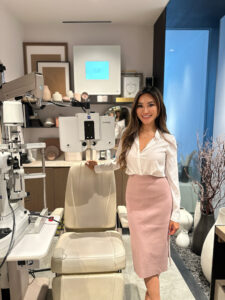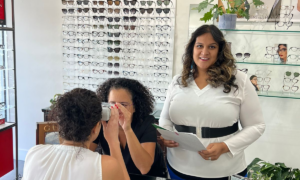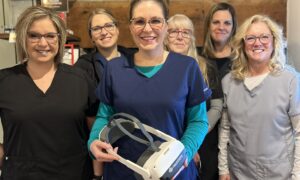
Dr. Tsai in one of her exam rooms in her office in the Hudson Yards area of Manhattan, New York City. Dr. Tsai says there are ways to leverage your dry eye investment to build your myopia management services.
Use established tools, knowledge & approaches to add this high-value, high-return service with mounting demand.
June 26, 2024
By Jennifer Tsai, OD
In my role operating a large dry eye practice, it’s easy to see the influence of DEWS and DEWS II on increased screening as part of routine eyecare across the profession, and the related patient revenue gains.
Similarly, research is now transforming our understanding of myopia, debunking previous perceptions of its harmlessness, and driving services growth and demand from parents. 1,2,3,4
Integrating myopia management into our daily work is a strategic choice to prioritize patient well-being while serving as a valuable revenue-building opportunity.
In my case, embracing myopia management substantially increased my revenue per patient on the scale of 500-700 percent, compared to industry averages.
Even with those types of returns, you might think that adding this type of care will take too much time and require too much investment. But if you’re already participating in the dry eye category, setting up your myopia management offerings can be easier, faster and require less of a leap than you think. Here’s why.
You Already Own the Essential Tools (Cost=$0)
When new research, recommendations and subsequent products changed the dry eye landscape, optometrists found they could still use simple diagnostics when adopting DED as a standard of care.2,3 Vital dye staining and merely pushing on the meibomian glands reveal most of the clinical picture.
For myopia, optometry practices already have the phoropter, lens bars and/or auto-refractor to assess refractive error subjectively and objectively in children.
The primary shift involves transitioning the dialogue from merely addressing blurred distance vision to actively managing the underlying disease of myopia. This change not only enhances patient and parent relationships through education, but also contributes to heightened patient satisfaction.
Other Articles to Explore
You Have Access to Expert Step-by-Step Guidance (Cost=$0)
Dry eye practice regularly turns to DEWS II for treatment and management guidance, along with other resources from professional associations and manufacturers. Flip the script to myopia, and you’ll find the same.
For instance, the International Myopia Institute’s series of white papers provide a framework for care, spanning from diagnosis to early treatment.12 Another valuable resource is CooperVision’s new MiSight 1 day QuickStart Program, a free resource that provides eyecare professionals with a suite of valuable resources including written guidelines, instructional videos and personalized support from CooperVision’s Myopia Management Specialist team.
Follow-Up Frequency Builds Referrals (Cost=$0)
We know that satisfied dry eye patients are never “one and done”—they return for additional treatments, and are quick to share their experiences with others in their social circles. You’ll find the same with myopia management.
The regular 4-6 month follow-up visit schedule for children in my care not only increases face-to-face interactions, but also opens doors to engage and attract younger siblings, cousins, sport and club teammates and friends. This taps into the influential potential of word-of-mouth referrals among parents, known for having the highest conversion rates.
As clinicians learned more about DED, they found simply treating symptoms with artificial tears didn’t resolve the underlying condition. This same reasoning can be applied to myopia—vision correction alone does not slow progression.
Today, optometrists have many effective myopia management options at their disposal. Think how far we’ve come in dry eye, and how we can do the same for the greatest ocular health issue facing millions of children today. Making the small and easy leap to myopia management can change patients’ lives forever, and change your business outcomes, too.
References
- The definition and classification of dry eye disease: report of the Definition and Classification Subcommittee of the International Dry Eye WorkShop (2007). Ocul Surf. 2007;5(2):75-92.
- Nelson JD, Craig JP, Akpek EK, et al. TFOS DEWS II Introduction. Ocul Surf. 2017;15(3):269-75.
- Craig JP, Nichols KK, Akpek EK, et al. TFOS DEWS II definition and classification report. Ocul Surf. 2017;15(3):276-83.
- Flitcroft DJ. The complex interactions of retinal, optical and environmental factors in myopia aetiology. Progress in Retinal and Eye Research. 2012 Nov.;31(6):622-60.
- Holden BA, Fricke TR, Wilson DA, et al. Global prevalence of myopia and high myopia and temporal trends from 2000 through 2050. Ophthalmology. 2016;123:1036–1042.
- Stapleton F, Alves M, Bunya VY, et al.: TFOS DEWS II Epidemiology Report.Ocul Surf. 2017;15(3):334–65.
- Farrand KF, Fridman M, Stillman IO, Schaumberg DA. Prevalence of Diagnosed Dry Eye Disease in the United States Among Adults Aged 18 Years and Older. Am J Ophthalmol 2017;182:90-8.
- Behrens A, Doyle JJ, Stern L, Chuck RS, McDonnell PJ, Azar DT. Dysfunctional Tear Syndrome Study Group. Dysfunctional tear syndrome: a Delphi approach to treatment recommendations. Cornea. 2006;25:900–907.
- Resolution: The Standard of Care for Myopia Management by Optometrists. World Council of Optometry. https://worldcouncilofoptometry.info/resolution-the-standard-of-care-for-myopia-management-by-optometrists/. April 13, 2021.
- Modjtahedi BS, Abbott RL, Fong DS, et al. Reducing the global burden of myopia by delaying the onset of myopia and reducing myopic progression in children: The Academy’s task force on myopia. 2021 Jun;128(6):816-826.
- Resnikoff S, Jonas JB, Friedman D, et al. Myopia— a 21st century public health issue. Invest Ophthalmol Vis Sci. 2019;60:Mi–Mii.IMI – Myopia Control Reports Overview and Introduction
- Wolffsohn JS, Flitcrofst DI, Gifford KL, et al. IMI – Myopia Control Reports Overview and Introduction. Invest Ophthalmol Vis Sci. 2019 Feb; 60(3): M1–M19.
- The WCO and CooperVision release, “A Practical Guide to Managing Children with Myopia. https://coopervision.com/practitioner/ecp-viewpoints/myopia-management/wco-and-coopervision-release-%E2%80%9C-practical-guide. Feb. 23, 2023.
Jennifer Tsai, OD, is a Manhattan, New York City-based optometrist, practice owner, speaker and healthcare advisor. She is the founder of LINE OF SIGHT, a modern concierge practice with an integrative holistic wellness approach to eyecare. Dr. Tsai specializes in dry eye treatment, ocular aesthetics, and myopia control with contact lenses such as orthokeratology and MiSight 1 day. She is seen as a leader in the wellness space and regularly advises healthcare companies. She also contributes as an eye care expert and speaker on national television outlets such as the Today Show, Oprah and Fox News, as well as publications like Allure, Seventeen and Shape. To contact her: hi@drjentsai.com

























